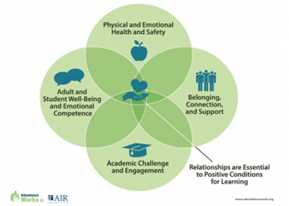Chronic absenteeism is defined as missing 10 percent of school days due to absence for any reason excused, unexcused, and suspensions – this is the equivalent of 18 days per school year.
Absenteeism can impact whether a student can read on grade level by third grade, achieve academically and socially in their middle years, and stay on track to graduate from high school. More than 8 million students were chronically absent before Covid, today, that number is almost double (attendanceworks.org).
As educators and leaders, we have asked: What can we do to begin to address chronic absenteeism?
Build upon relationships. Make sure our students know they matter each and every day.
Survey students and hold student forums, ask students – What do you like about our school? What is an area that you, as a student, would like us to focus on? Do students agree or disagree with the statement, “I feel welcome at school.” Discuss the results of the survey with the students. (PLC has a great tool – Data Triangle: The Student Voice Survey.) When we give students a voice and make changes based on their input, we begin to build a student-centered culture. That culture reinforces to our students that they are important and the reason why we are here.
Create interventions for at-risk students.
When a student is absent, we need to immediately call home to check in with a personal phone call. That reinforces the message that ‘we care about you’. After a student returns to school, we must welcome them back and tell them we missed them! If a student is beginning to miss multiple days of school each week or month, let’s create a daily ‘check and connect’ to identify the ‘why’ behind the absences. Make sure the student support team develops a plan for wrap-around services to support the student with both in-school and community agencies. Once an issue is identified, it is critical that we create the sense of urgency to support the student.
Educate parents about the importance of attendance.
- Send out weekly messages related to good attendance.
- Provide helpful tips on what parents can do to address attendance concerns.
- Identify the contact information for school staff who can help with attendance concerns.
- Develop proactive messages that share ideas of how parents can support their child’s attendance.
Let them know Why – Share impactful data: By 6th grade, absenteeism is one of three signs that a student may drop out. - Encourage your child to join meaningful after school activities including sports, music, or clubs.
Put all students on a winning streak.
When a student returns after an absence, develop a plan to address the learning they missed. We cannot assume that they will learn it on their own. We need to assist them as a school-wide effort to create small, structured learning opportunities. Meet them where they are at and provide flexibility to fit their schedule by creating in-school and after-school opportunities that focuses on data informed gaps and supports individual learning styles.
Make sure your systems recognize all students. Instead of focusing solely on ‘Honor Roll Students’, focus on ‘On A Roll Students’. Provide acknowledgements for students who are making progress toward their attendance, behavior, and academic goals. Establish student-led conferences providing students the opportunity to present to their parents their goals and action steps for reaching their goals.
Develop systems to collect and analyze attendance, behavior, and academic data on a regular and consistent basis.
At both the district and building level begin to collect and analyze data to tell a story of why students are not coming to school. Start by looking at the system. Are our policies and practices in alignment with what our data is telling us? As a Learning Team, put this issue front and center at faculty meetings. Use a data protocol so your team is action-oriented and solutions-based. – Ask questions about what you notice at certain grade levels; Identify current realities using data; Answer your questions using the data; Research and pick a strategy; Act as a team – “We plan to…”
Create positive conditions for learning that lead to students being engaged and attending regularly.
Chronic Absenteeism can feel overwhelming to educators. We need to develop district and building level task forces that come up with ‘quick-wins’ for students, families, and staff. Let’s create SMART goals with 3-5 action steps that help us to focus our work and begin systematically solving a much bigger issue. And always – Celebrate individual student increases in attendance and building decreases in chronic absenteeism, no matter how small. Each is a step forward in creating a student-centered culture of success for all.
Accountability and School Improvement Experts:
PLC Associates Inc. is well-known for their capacity to engage in explicit diagnostics and provide reports and recommendations with the level of detail and specificity that leadership requires to move schools into good standing and sustained high performance.
Currently, we are engaged in targeted, multi-year school turnarounds and key initiatives with districts of all types across NYS.
Our range of survey tools and metrics:
- Identify challenges, needs, and strengths in systems
- Isolate points of entry for improvement plans, carefully considering leverage points
- Create efficacy and results within the district or school.
Accomplish Great Things in Your District
We work with you to close gaps, replicate best practices, and build high-impact, sustainable systems.
Let’s Chat About How We Can Help
Reach out to PLC Associates for a 15-minute solutions conversation.
Directly with Penny Ciaburri at 585-703-7521 and would look forward to talking with you.
Accomplish Great Things in Your District
We work with you to close gaps, replicate best practices, and build high-impact, sustainable systems.
Let’s Chat About How We Can Help
Reach out to PLC Associates for a 15-minute solutions conversation.
Call us directly at 1-800-774-6801. We look forward to talking with you.

